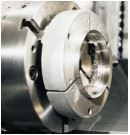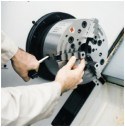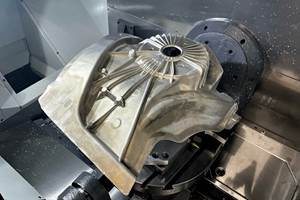Quick Change Turns Time Into Money
Quick-change chuck jaws make undeniable sense for any kind of high-mix lathe production. This shop finds them the right choice for medium-run and family-of-parts production too.
Share







ECi Software Solutions, Inc.
Featured Content
View MoreThis is so fundamental, it's hard to know where to begin. So let's just take it from the top. There are only two modes a machine tool can be in that really matter. One is when the machine is in production, making parts. The other is when it is not. Now, there are many ways to complicate this issue. For instance, there can be a lot of reasons why a machine is not making parts, and some shops like to track and analyze each and every one. If that's you, you need read no further because you probably already get it. For everyone else, here's the simple truth: When a machine is making parts, it is making money. When a machine is not making parts, it is costing money. So it stands to reason that any reasonable investment that makes a machine make parts more of the time is going to make money too.
The question is, what's reasonable? Let's make that simple, too. If you get more back than you spent, it's a good investment. Take quick-change chucks for example. Say your machine time is worth $60 an hour, and it takes a half-hour to change jaws on average. That means a jaw change costs you thirty bucks. However, if a quick-change system cuts the time to five minutes, that means you get back $25 dollars worth of machine time with each jaw change. Count up all the jaw changes over the course of a year, and you'll probably be surprised at how big that number gets.
That's how they figured it at the Morton Grove, Illinois, plant of John Crane International. They did the math, and found that quick-change chucks were an easy call, not just for the short run work, but for medium volumes as well. But besides making dollars and sense, quick-change improves their responsiveness as well.
Organizing Production
If you're unfamiliar with Crane, it is a global manufacturer of mechanical shaft seals, produced in more than 20 plants located around the world. Designed to contain fluids or gases around rotating shafts, as well as to inhibit the penetration of external contaminants, applications for Crane's products can be found in a wide range of industries including petroleum, chemical, pulp and paper, food and beverage, power generation, water and automotive. (For an excellent presentation on Crane's products, see their Web site at www.johncrane.com) The Morton Grove plant is a sizeable operation with some 1500 people, about 70 of which are machinists. In total there are 26 CNC lathes.
Historically, seal components were turned on a combination of manual equipment and some Warner & Swasey NC lathes. Economical lot sizes were considered to be several hundred pieces. But like many companies in the late 1980s, Crane began to look for ways to minimize the amount of finished product inventory. One contribution to that end would be to let batch sizes be determined by real orders or short-term forecasts, rather than by economical order quantities. That created an imperative to reduce setup time, as the inevitable result would have to be higher machine changeover frequency due to progressively smaller lot sizes. Something in the shop was going to have to change, particularly given that common practice at the time was to set up one lathe for first-end operations and another lathe to finish the second end.
Then in 1988 the company began to systematically upgrade its production turning capabilities. According to the supervisor of tool engineering, Mike Eklove, the first purchase was an Okuma large-bore turning center. The 4½-inch through-hole let the shop make a wide range of parts out of barstock, which was a more efficient process in total. But they also needed an efficient means to change over from one size of stock to another, so they fit the machine with a quick-change chuck from SMW Systems (Santa Fe Springs, California). The chuck has a serrated interface between the master and top jaws, and all jaws are locked into the serrated seat with just a quarter-turn of a locking screw. To change the grip diameter, all a machinist had to do was unlock the jaws, slide them to the proper position in the guideway, and lock. It literally took a few seconds to do.
Equally important, quick-change chucking made it practical to eliminate a second setup on another machine. This was accomplished by machining two steps on a set of jaws, one for the first operation and the other for the second operation. So, once the first operation was complete, all they had to do was reorient the jaws in the stroke and they were ready to begin second-side turning.
Since then, Crane has systematically added CNC turning capacity, virtually all fit with quick-change chucks, including nine 15-inch chucks and thirteen 12-inch chucks. Even so, says Mr. Eklove, Crane does everything they can to further minimize setup time. For example, most of the machines are dedicated only to a relatively narrow range of stock sizes, which minimizes the change requirements both in the workholding and in the bar feeds. Moreover, on any given machine, they take stock size into account as they schedule work, ganging like size runs together wherever possible. Typically, they begin each Monday morning with the smallest size stock and then systematically work up over the course of the week.
Efficient Short-Run Production
Perhaps the most critical role that quick-change chucks play is in Crane's rapid response cell—sort of a factory within a factory—which they call the "adaptive hardware area." It includes seven Okuma turning centers, all geared for short-run work. Here, flexibility is paramount with typical lot sizes of one to three pieces, and delivery requirements often marked "as soon as possible."
In most cases, the need to perform both first- and second-side turning operations on the same machine means changing from hard jaws for the first side to soft jaws for the second side, then back to hard jaws to set up for the next workpiece. On conventional chucks, changing from hard to soft jaws would typically take 15 minutes to change jaws, and often another 30 minutes would be required to rebore the soft jaws once they were mounted due to inadequate repeatability of the remounted soft jaws. Averaged across all the work, each setup burned a half-hour of production time.
With the quick-change chucks, however, jaw changes are executed in less than two minutes, and entire setups now average just five minutes. Considering that they average eight setups per shift per machine in the adaptive hardware area, it's easy to see how that investment pays off. "When we did the original justification, we figured something like 75 cents a minute," says Mr. Eklove. "It's more now. When you figure that we're doing eight setups a shift, and saving 25 minutes a setup, it adds up fast."
A particular advantage of quick-change chucks is that the better systems today have grown highly repeatable, which means reboring operations can often be eliminated on repeat setups with an existing set of soft jaws. SMW claims, for instance, that they can hold 0.0003-inch TIR repeatability with remounted wraparound jaws (which Crane uses frequently for thin-walled parts), or 0.0002-inch TIR repeatability with narrower jaws. In practice, Mr. Eklove says that in chucking applications they typically hold total workpiece runout from front to back between 0.0008 and 0.0010 inch on a workpiece 2 to 3 inches long. Considering that Crane requires tolerances in the range of 0.002 to 0.003 inch, the workholder accuracy is more than sufficient to eliminate rebores of existing jaws.
The upshot of it all is that Crane has actually been able to improve quality at the same time that they've increased efficiency and flexibility. Part of that payback is better responsiveness to customer needs. True, it's hard to put a number on all of that, but at John Crane there's little doubt that it adds up to a bargain.
Related Content
Workholding Fixtures Save Over 4,500 Hours of Labor Annually
All World Machinery Supply designs each fixture to minimize the number of operations, resulting in reduced handling and idle spindle time.
Read MoreFixturing Castings Made Simple Through Adhesive Workholding
When a casting proved too malleable for traditional gripping, Thomas/Euclid Industries adopted — and succeeded with — Blue Photon adhesive workholding.
Read MoreUsing Jaws as Grippers Enables Flexible, Low-Cost Automation
VersaBuilt’s automation systems significantly boosted Innovative Fabrication’s revenue. In return, the shop has helped VersaBuilt optimize its products.
Read MorePrioritizing Workholding Density Versus Simplicity
Determining whether to use high-density fixtures or to simplify workholding requires a deeper look into the details of your parts and processes.
Read MoreRead Next
Registration Now Open for the Precision Machining Technology Show (PMTS) 2025
The precision machining industry’s premier event returns to Cleveland, OH, April 1-3.
Read MoreBuilding Out a Foundation for Student Machinists
Autodesk and Haas have teamed up to produce an introductory course for students that covers the basics of CAD, CAM and CNC while providing them with a portfolio part.
Read More
















































.jpg;maxWidth=300;quality=90)







